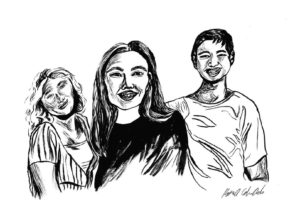San Francisco Unified School District passed a new resolution to improve mental health services in high schools last June. Stress and anxiety have been increasing in all San Francisco high schools, counselors and administrators say. New programs, started with input and leadership from students, are paving the way for the future of mental health services.
SFUSD’s initiative was created through the work of Youth Movement of Justice and Organizing, or MOJO, the teen leadership group connected to the Chinese Progressive Association, an organization dedicated to the education and empowerment of the Chinese members of San Francisco’s working-class. At a Board of Education meeting last May, the group recommended peer counseling programs, as well as increased student input on mental health services for San Francisco public high schools. The resolution was passed, and MOJO’s recommendations are being implemented this fall.
MOJO’s campaign started in 2017 when they sent out a survey to 1000 students in San Francisco public high schools about mental health. They found that students of color and students who identified as LGBTQ were much less likely to seek out mental health services. Overall, only 50% of the students taking the survey had ever been into a school wellness center.
Nevin Chin ’20, one of the leaders of Youth MOJO, says that the survey shows that resources, such as counseling and mental health programs “were being underutilized and there are significant barriers arising from either discomfort with talking to adults or strangers or the outreach that the school was using.”
Chin says that one of the main issues with access to counseling and other mental health resources in public schools is that many students feel uncomfortable talking to professionals, especially at school, about personal issues. This student experience is shaping a new wave of mental health initiatives and programs in all schools, both public and private, including the SFUSD resolution and other programs throughout the city.
At the Urban School of San Francisco, there is now a three-year required class called Being at Urban, in which students are able to share their experiences with one another once a week in a safe and comfortable space. The course was based on feedback that students were in need of more resources to strengthen their ability to deal with mental health struggles. According to Kaern Krelying, Urban’s head counselor, the classes, which are led by adults, aim to enforce the idea that “mental health is for everyone,” and that everyone should be developing skills to take care of themselves.
A peer resource program at Urban has been active for almost 25 years and is completely student-led. The goal is for students to be able to be more honest with themselves in this teen-only environment, without the fear of surprise or judgment from adults.
“There is a way that young people talk to each other that is different than the way that young people talk across that power differential [to] adults,” said Kreyling.
One of the risks of students backing away from traditional counseling services, however, is an “overly self-critical self-diagnosis.” Kreyling has noticed a recent trend in students being overly judgemental while attempting to label issues with their mental health.
The stigma around mental health is still very present, even with these increased programs to address it. Kreyling says that “there’s a lot of desire in private school culture to help the world and help others and be the helper, and not be the helped.”
A new mental health club at Lick aims to do both. Headspace, led by Greg Kalman ’21 and Natalie Keim ’21, was created to be a healthy space on campus for a discussion about shared experiences at Lick. Similar to peer counseling, a program that LWHS recently removed due to scheduling conflicts, it will be meeting without adults. The teen-only discussion will hopefully open up space where students feel more comfortable sharing personal experiences.
Kalman thinks that the next steps for Lick’s mental health program should be much more driven by student input than it is now. He says the schools’ upcoming policies such as banning the ability to double in a subject (starting next year), put in place partly reduce stress, “are basically just faculty and adult based and are not as effective.”
However, administrators and counselors take a lot into account when making decisions. Although student input is important, it is not the only thing that is considered. Assistant Head of School Randy Barnett says that the decision-makers are “responsible for the wellbeing of [the] students and the best education possible,” and that the course load change was made after “monitoring student health and processing lots of feedback.”
Barnett says that he and fellow staff members are always listening to student input. But through their years of professional experience, they sometimes have a different perspective on what Lick students need.
Explaining the decision to limit student course load, he says that “growing up takes a while, you don’t know what you don’t know, and people need to have constraints around them. They’ll just burn themselves out.” According to Barnett, students with too much on their plates are unable to maintain success with every class, sport, art, and volunteer job, which contributes to mental health struggles.
In terms of the counseling program itself, Kalman thinks the main issue at Lick is accessibility. People know who the counselors are and where to find them, but Kalman says that “where people are uncomfortable is understanding that they can go.” According to Kalman, students know that their experiences are unique to Lick’s current social and academic climate, which often brings them to peer spaces, rather than a conversation with a trained adult, who can’t always relate to the current experience.
Lick, Urban, and SFUSD all have very different approaches to mental health services and initiatives they offer. Among all, however, it is clear that student voices have power. When students communicate their needs, it is typically well-received by counselors and administrators. And when it isn’t, students will take things into their own hands.







